Book contents
- Patrimony and Law in Renaissance Italy
- Patrimony and Law in Renaissance Italy
- Copyright page
- Contents
- Acknowledgments
- 1 Introduction
- 2 Bartolus and Family in Law
- 3 The Divisible Patrimony
- 4 Property of Spouses in Law in Renaissance Florence
- 5 Societas and Fraterna of Brothers
- 6 Fideicommissum and Law
- 7 Estate Inventories as Legal Instruments in Renaissance Italy
- 8 Prudence, Personhood, and Law in Renaissance Italy
- 9 Addendum
- 10 Conclusion
- Bibliography
- Index
2 - Bartolus and Family in Law
Published online by Cambridge University Press: 24 February 2022
- Patrimony and Law in Renaissance Italy
- Patrimony and Law in Renaissance Italy
- Copyright page
- Contents
- Acknowledgments
- 1 Introduction
- 2 Bartolus and Family in Law
- 3 The Divisible Patrimony
- 4 Property of Spouses in Law in Renaissance Florence
- 5 Societas and Fraterna of Brothers
- 6 Fideicommissum and Law
- 7 Estate Inventories as Legal Instruments in Renaissance Italy
- 8 Prudence, Personhood, and Law in Renaissance Italy
- 9 Addendum
- 10 Conclusion
- Bibliography
- Index
Summary
Bartolus of Sassoferrato, the leading jurist of his day, whose influence spanned several centuries, first formulated an equation of family and its property (substantia) that cast an image of family enduring over time in the immediate passage of property from father to son. That tie was so pivotal that a son could be termed, however incorrectly in strict legal terms, as a co-owner of the estate with his father. Disinheritance was difficult to conceive of in these terms, although it was an allowed legal institution. Subsequent jurists followed Bartolus's lead, even though they were likely to face only situations where the paradigmatic passage of haereditas from father to son was not possible.
- Type
- Chapter
- Information
- Patrimony and Law in Renaissance Italy , pp. 19 - 41Publisher: Cambridge University PressPrint publication year: 2022

